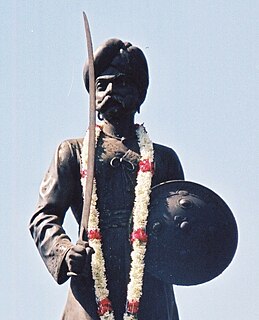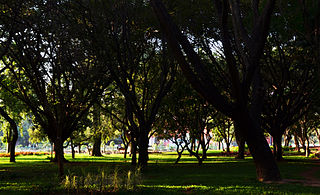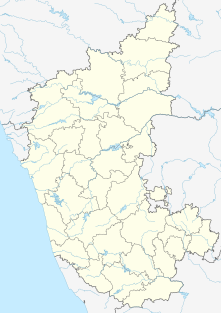
NadaprabhuHiriya Kempe Gowda, also known as Kempe Gowda, was a chieftain under the Vijayanagara Empire. The city of Bengaluru, capital of the Indian state of Karnataka, was founded by Kempe Gowda in 1537.

Bangalore is the capital city of the state of Karnataka. Bangalore, as a city, was founded by Kempe Gowda I, who built a mud fort at the site in 1537. But the earliest evidence for the existence of a place called Bangalore dates back to c. 890.
The Bangalore Cantonment (1806–1881) was a military cantonment of the British Raj based in the Indian city of Bangalore. The cantonment covered an area of 13 square miles (34 km2), extending from the Residency on the west to Binnamangala on the east and from the Tanneries in the north to Agram in the south. By area, it was the largest British military cantonment in South India. The British garrison stationed in the cantonment included three artillery batteries, and regiments of the cavalry, infantry, sappers, miners, mounted infantry, supply and transport corps and the Bangalore Rifle Volunteers. The Bangalore Cantonment was directly under the administration of the British Raj, while Bangalore City itself was under the jurisdiction of the Durbar of the Kingdom of Mysore.

Cubbon Park, officially called Sri Chamarajendra Park is a landmark 'lung' area of Bengaluru city, located within the heart of the city in the Central Administrative Area. Originally created in 1870, when Major General Richard Sankey was the then British Chief Engineer of Mysore state, it covered an area of 100 acres (0.40 km2) and subsequent expansion has taken place and the area reported now is about 300 acres (1.2 km2). It has a rich recorded history of abundant flora and fauna plantations coupled with numerous impressive and aesthetically located buildings and statues of famous personages, in its precincts.

Bangalore Fort began in 1537 as a mud fort. The builder was Kempe Gowda I, a vassal of the Vijaynagar Empire and the founder of Bangalore. Hyder Ali in 1761 replaced the mud fort with a stone fort and it was further improved by his son Tipu Sultan in the late 18th century. It was damaged during an Anglo-Mysore war in 1791. It still remains a good example of 18th-century military fortification. The army of the British East India Company, led by Lord Cornwallis on 21 March 1791 captured the fort in the siege of Bangalore during the Third Mysore War (1790–1792). At the time the fort was a stronghold for Tipu Sultan. Today, the fort's Delhi gate, on Krishnarajendra Road, and two bastions are the primary remains of the fort. A marble plaque commemorates the spot where the British breached fort's wall, leading to its capture. The old fort area also includes Tipu Sultan's Summer Palace, and his armoury. The fort has provided the setting for the treasure hunt in the book Riddle of the Seventh Stone.

Bengaluru Pete is an area of Bangalore city which was established by Kempegowda I in 1537 with roads laid out in the cardinal directions, and entrance gates at the end of each road. Kempegowda also termed the Pete he built as his "gandu bhoomi" or "Land of Heroes". Pete forms a well–defined body of markets which were associated with various trades and professions of the populace in the locality markets and given the names of trades pursued in such markets. The well known markets are the Tharagupete–market for grains, the Balepete – for Bangles and musical instruments, the Chikkapete and the Nagarthpete for textile trade, the Ballapurpete and the Ganigarapete market where oil is extracted by people of the Ganiga community, the Tigalarapete–flower market of gardeners, the Cubbonpete – textile manufacture by people of the Devanga community.

Bangalore (Bengaluru), the capital of Karnataka state, India, reflects its multireligious and cosmopolitan character by its more than 1000 temples, 400 mosques, 100 churches, 40 Jain derasars, three Sikh gurdwaras, two Buddhist viharas and one Parsi fire temple located in an area of 741 km² of the metropolis. The religious places are further represented to include the few members of the Jewish] community who are making their presence known through the Chabad that they propose to establish in Bengaluru and the fairly large number of Bahá'ís whose presence is registered with a society called the Bahá'í Centre. In the demographically diverse, major economic hub and India's fastest-growing major metropolis of Bengaluru, the number of religious places of each religion reported reflects growth in proportion to the population growth. According to the 2001 census of India, 79.37% of Bangalore's population is Hindu, roughly the same as the national average. Muslims comprise 13.37% of the population, which again is roughly the same as the national average, while Christians and Jains account for 5.79% and 1.05% of the population, respectively, double that of their national averages. Anglo-Indians also form a substantial group within the city.
William Arthur was a Wesleyan Methodist minister and author.
William Reeve (1794-1850) was a London Missionary Society missionary to India, author of an early dictionary of the Kannada language, and translator with John Hands of the Bible into Kannada. The dictionary was compiled from 1827 to 1834, when he was in Bangalore. His connection with the Society ceased 23 November 1835.

John Hands was a missionary of the London Missionary Society in India and, with William Reeve, translator of one of the first Bible translations into Kannada (1820). Hands founded the mission station in Bellary in 1810, after having failed to establish a base at Seringapatam.
The Central Karnataka Diocese is one of the twenty-two dioceses of the Church of South India covering the central part of Karnataka.

Cox Town is a suburb located North in the Bangalore Cantonment, named after the last Collector and District Magistrate of the Bangalore Civil and Military Station, Alexander Ranken Cox, Indian Civil Services. It is one of the suburbs which came out of the plan to de-congest thickly populated areas of the Bangalore Cantonment after the bubonic plague. Agricultural fields were converted for this purpose, and town was planned according to modern hygienic standards, with drainage and conservancy conveniences. Cox Town is bound by the Bangalore-Madras Railway line on the North and East, Wheeler Road in the East and the Ulsoor Polo Ground in the South. It comprises the localities of Heerachand Layout, Sindhi Colony, Jeevanahalli, Doddigunta, and roads such as Assaye Road, Charles Campbell Road, Wheeler Road, etc. and is adjoining the suburbs of Fraser Town, Clevland Town and Cooke Town, with easy access to the Bangalore East Railway Station, Ulsoor, Lingarajpuram, Shivaji Nagar. Cox Town is a well planned, posh and preferred suburb in the Bangalore Cantonment, created during the British Raj. The residents of Cox Town follow a liberal 'live a let live'attitude, with suburb still retaining much of its green cover, without excessive commercialisation. In 1988, the BBMP renamed Cox Town as Sarvagnanagar, after a 16th-century saint poet. However, the name has not caught on and continues to be popularly known as Cox Town.
Goodwill's Girls School is located at Promenade Road, Fraser Town, Bangalore Cantonment. Formerly known as the Wesleyan Tamil School, the school was renamed after Rev. Fred Goodwill, a British Missionary and Tamil scholar, who served as the manager of the school, in his capacity as Superintendent of the Wesleyan Tamil Mission, Bangalore and Kolar Gold Fields.

Gubbi Town 20 km from Tumakuru and 90 km from Bengaluru along NH-206. Gubbi ULB Contains 17 Wards and equal number of Councilors. The population of the Gubbi Town is 18,457 as per Census 2011. The total area of the Town is 6.67 sq. km. Gubbi was earlier known by the name Amaragonda. Gubbi is famous for Gosala Sri Channabasaveshwara Swamy Temple of Veerashaiva sect and Sri Chidambarashrama.
The Rice Memorial Church is located in the busy Avenue Road, Bangalore Pete. It is named after Rev. Benjamin Holt Rice, a missionary of the London Missionary Society (LMS), a Canarese scholar and a pioneer of education in the Bangalore Pete region. The Rice Memorial Church stands on a busy street in the midst of temple, dargahs, book shops and heavy traffic, with its colonial British structure appearing to be out of place in the traditional Bangalore market district. The church stands on the site of the London Mission Canarese Chapel built by Rev. Rice, which itself was built on the site of the first Canarese chapel built by William Campbell in 1834. The church is a stone building in the European Classical style, with Tuscan columns, pediments and keystone arch windows. The church building has been demolished and raised at least 3 times, with the current structure consecrated in 1917.
The Hudson Memorial Church is located in the Bangalore Pete, Hudson Circle, surrounded by the Office of the Bangalore Corporation, Ulsoor Gate Police Station, Cubbon Park and Kanteerava Stadium. The church was established in 1904, and is a Kannada CSI church of the Bangalore Diocese. The church has around 4000 registered members and is named after Rev. Josiah Hudson, a missionary, Canarese scholar and educationist who started many Canarese schools in the Bangalore Petah region. The church was earlier known as the Wesleyan Mission Canarese Chapel, and was located in Ganikara Street, Nagarathpet, and moved the current location at Hudson Circle and renamed as Hudson Memorial Church in 1904. The church attracts people of all faiths, who visit the church to seek blessing, especially in Thursdays and Sundays.

Thomas Hodson was a Wesleyan Missionary, who served in India, in the Wesleyan Canarese Mission, at the Bangalore Petah and Gubbi. He helped in running the first Wesleyan Mission Canarese school in the erstwhile Mysore State. Hodson was a linguist and a Kannada scholar, and was also fluent in Tamil and Bengali. He helped in establishing the Wesleyan Canarese Chapel at Nagarthpete in the Bangalore Petah. In 1864, Hodson wrote An Elementary Grammar of the Kannada, or Canarese Language, a treatise on the grammar of the Kannada language.
The East Parade Church, consecrated in 1865, is located on Mahatma Gandhi Road, in the Bangalore Cantonment. The church comes under the Karnataka Central Diocese of the Church of South India. Started in the early 19th century as the Wesleyan Mission Chapel by Wesleyan believers of the Madras Army with Tamil and English services, the Church now has services in Tamil and Malayalam. The name East Parade comes from its location on the East of the Parade Grounds of the Madras Engineer Group (MEG) regiment. The present church building was raised in 1865, on the site of the old Wesleyan Mission Chapel, with an inscription dated 6 October 1863 marking the laying of the foundation stone.
The United Mission School is located on Mission Road, Bangalore and is managed by the Church of South India. The school offers English medium education and is affiliated to the Karnataka Secondary Education Examination Board. The school has classes from Year 1 to Year 10. In 1993, the United Mission Degree College was established on the same campus, offering Bachelor of Commerce and Bachelor of Business Management courses, affiliated to the Bangalore University.
Daniel Sanderson was a Wesleyan Missionary, who served in India, in the Wesleyan Canarese Mission, at the Bangalore Petah, Mysore, Tumkur and Gubbi, between 1842–1867. Sanderson was a linguist and a Kannada scholar. He is credited with co-authoring the first Kannada-English dictionary, published in 1858 by the Wesleyan Mission Press with the financial support by Sir Mark Cubbon. He also translated Lakshmisa's magnum opus, the Jaimini Bharata, into English. On return to England, he was appointed as the director of the Richmond Theological College.












